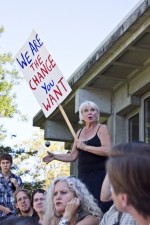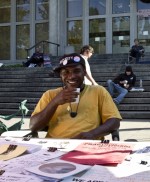A couple of Occupy Santa Cruz campers make a water run to supply certain… (Dan Coyro/Sentinel)
SANTA CRUZ – Dreamcatcher, which is how everyone knows him, says his job is to keep the peace, counting among his credentials 11 years in prison, five bullet holes and two strikes toward a life sentence in state prison.
Verbose and quick with a smile, Dreamcatcher sleeps in a tent by a large teepee just off Water Street in San Lorenzo Park, the teepee serving both as a community gathering space and a fault line in the burgeoning Occupy Santa Cruz movement, a growing part of the international Occupy Wall Street protests.
While the Sentinel has a policy against using pseudonyms, in this case, many of the people participating refuse to give their legal names.
In place for about a month, an encampment has grown to number scores of tents, an increasing number of them occupied by homeless people. While the camp has grown, people like Dreamcatcher have worked to maintain order and keep the movement going forward, even as it draws elements from last year’s controversial camping ban protest – though it so far has avoided the same fate.
“It’s been a very dynamic, delicate process,” Dreamcatcher said, explaining that he knows many protesters personally and steers them from trouble before it begins. “I know everyone here by name. That is my gift.”
Filled with activists fed up with the direction of the country and sustained by donations of food and money (and frequent honks from passing motorists), the Occupy Santa Cruz movement is undoubtedly growing. During daily general assembly meetings, sometimes hundreds show up to help guide the effort.
Set up at the main county courthouse, it exhibits an impressive level of discipline, deploying a designated cook, routine trash pickups and periodic movement of tents to try to keep the park’s grass alive. Protesters say local unions have been supportive, and professionally produced signs are on display. Occupy Santa Cruz even has its own T-shirts.
And protesters say they have no intention

Although James Smyth has a home in Bonny Doon and works as a landscaper, he spends some nights in the Occupy Santa Cruz camp working with other campers to change the system he says is obviously failing. (Dan Coyro/Sentinel)
of leaving anytime soon.”Indefinitely,” said James Smyth, a 26-year-old landscaper who lives in Bonny Doon but has spent several nights along the bank of the San Lorenzo River. “Until the wealthiest 1 percent is willing to change the way they conduct themselves in society, the other 99 percent will not be deterred from moving forward in this occupation.”
DIFFERENT TRACK
Locally, the official response to the camp has been very different from responses in other cities, where a handful of crackdowns have led to a backlash that has seem to galvanize the Occupy Wall Street movement. In Oakland, a 24-year-old ex-Marine was seriously wounded when police tried to sweep an encampment from Frank Ogawa Plaza.
“Whatever the

Nearly 100 tents divided into well-defined political sections are sprawled across the benchlands of San Lorenzo Park making up the all-encompassing Occupy Santa Cruz protest camp. (Dan Coyro/Sentinel)
big cities are doing, Santa Cruz wants to do the opposite, because they figure that’s going to be the right thing to do. Because the more you try to fight dissension, the more dissension you’ll breed,” said John Crying Rain, one of the campers.There has been no sign city and county officials intend to break up the camp. County Public Health Director Bob Kennedy said there have been no complaints, making it very different from last year’s months-long camping ban protest, when authorities eventually made the controversial decision to break up a camp also located at the county courthouse.
“This is a totally different group,” Kennedy said.
Several protesters think they are being protected this time around by local elected

While the camp rules are posted for all to see, still the aroma of marijuana wafted Tuesday morning throughout the camp sprawled across the benchlands of San Lorenzo Park. (Dan Coyro/Sentinel)
leaders, particularly within the city of Santa Cruz. Santa Cruz police spokesman Zach Friend said it was the department that reached out to City Hall, and acknowledged that the city’s approach differs from other locales.”It was important to us to have city management and other elected officials understand what our operational philosophy would be,” Friend said. “From Day One, it’s been important to take a balanced approach. We’ve seen what hasn’t worked in others cities, and we’ve always attempted to have some lines of communication with (protesters).”
Besides the now-infamous Oakland sweep, which has placed Mayor Jean Quan’s administration under a microscope, other crackdowns on Occupy camps have led to a backlash, and pose

A pedestrian hurries past elements of the Occupy Santa Cruz camp Tuesday. The camp has spilled out onto Water Street. (Dan Coyro/Sentinel)
a politically thorny situation for elected officials.In Nashville, Gov. Bill Haslam faced tough questions after a sweep there led the arrests of two reporters covering the protest. A federal judge later issued a temporary restraining order protecting the camp from being disbanded.
More crackdowns, including one at Zuccotti Park in Manhattan, which has been the base of the Occupy Wall Street movement, and another in San Francisco, were called off at the last minute.
STAYING PUT
That doesn’t mean police here aren’t paying attention. They make daily visits, occasionally issuing tickets for open flames or smoking in the park. But so far, no camping tickets have been issued.
Activist lawyer Ed Frey, who has spent time in County Jail for previous camping citations, has been assisting the movement, doing everything from helping to draft a mission statement to renting a portable toilet.
“We’re not leaving,” Frey said. “This is it. We’ve had too much dysfunction and suffering. Needless suffering.”
So far, the separate peace between the homeless portion of the encampment and the core of activist Occupy Santa Cruz protesters seems to be working.
“We pretty much police our own, you know?” said a man who gave his name as Dread-I, part of the homeless part of the camp. “We police ourselves so the police don’t have to come down and do nothing. … We’ve all come together as one.”
When tensions do emerge between the two sides, the group works to deal with them internally. It seems part of a code, a determination by protesters to manage their own affairs and keep their mission focused on larger issues of economic disparities and a political system they say favors the rich and powerful.
“We know the world is watching,” said 26-year-old Isaac Collins, on hiatus from a job harvesting grapes to become a part of the movement. Collins has a home and an associate’s degree in communications from Cabrillo College, but has been staying at the encampment.
But some clear lines do develop when it comes to allocating scarce resources – namely, dinner.
Under a makeshift tent fashioned from blue tarps sits shelves lines with canned goods. A camp cook feeds 50 to 60 people at dinner, but she said the food is for activists and homeless people who help with the movement – not simply a free meal for anyone who wants it.
Campers says the food there is good, and not just when local businesses such as Domino’s or Pizza My Heart drop off donations.
“She’s cooked some bomb food,” said protester Michael Hawk.
Protesters remain optimistic that the movement will lead to permanent change. And they have no intention of going anywhere soon, saying their actions are protected by the First Amendment.
“Even if you put an Occupy Santa Cruz sign on your tent at Pogonip, they won’t (evict you), because that sign is saying, ‘Look, I’m behind this movement. It’s a Free Speech movement,'” said Smyth, the landscaper.
But Friend said the police department would like to know what the camp’s exit plan might be.
“We can all agree that they can’t permanently stay in this location,” he said.


 Plus Letters to the Editor
Plus Letters to the Editor




 How does Occupy Santa Cruz fit into the global movement for democracy?
How does Occupy Santa Cruz fit into the global movement for democracy? “I am not happy about the fact that there’s so much financial inequality right now, and that that plays out in a stronger corporate influence of politics,” says Yasmeine Mabrook, a woman in her 20s who sits on the courthouse steps awaiting the General Assembly meeting that OSC holds nightly. “The only way to fight back is to get people involved and working towards change.”
“I am not happy about the fact that there’s so much financial inequality right now, and that that plays out in a stronger corporate influence of politics,” says Yasmeine Mabrook, a woman in her 20s who sits on the courthouse steps awaiting the General Assembly meeting that OSC holds nightly. “The only way to fight back is to get people involved and working towards change.”



















